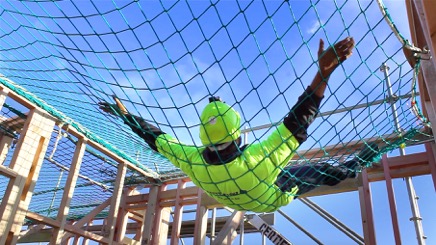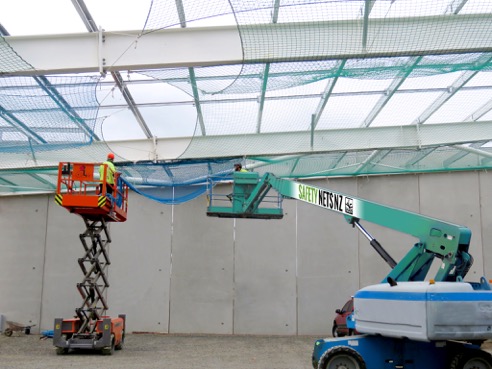
The use of safety nets as a means of providing a robust fall protection system on construction sites has become a common sight over recent years.
Safety nets have become increasingly popular since 2009, when the old Department of Labour launched the Preventing Falls From Heights project that aimed to achieve a 25 per cent reduction in fatalities resulting from falls from height by 2020.
Three years later the department’s successor, WorkSafe New Zealand, developed the Best Practise Guidelines for Working on Roofs, which led to WorkSafe advising the residential construction sector that fall protection standards needed to improve.
The Best Practise Guidelines for Working on Roofs identified “soft fall arrest” collective passive systems as the preferred option in the sector as they allow work to continue at height without restricting workers’ movement.
Safety nets therefore came to the fore as they offer numerous benefits and advantages when used as the primary means of providing a fall arrest solution on construction sites:
- they provide a collective, passive solution meaning that there is no reliance on worker action to ensure their own safety with regards to fall protection systems – they don’t have to clip harnesses on and off every time they move
- the net system minimises the impact on builders works meaning that works can continue both above and below the net, unlike with other fall protection systems such as air bags
- there is no reliance on builders to move the protection system around the property to suit varying work locations – the nets are installed by certified installers and removed upon completion of the builders’ work so they don’t need to do anything
- the nets are quickly installed and removed , thereby having very little impact on project time lines
- nets provide an extremely cost-effective solution, and add minimal cost to the overall project
- nets come in varying sizes so that they can be “dressed” to suit any area that requires protection
- the nets are fitted as close as possible to the working level, thereby minimising fall distance into the nets which is an advantage over other means of fall protection where fall distances and greater – the greater the fall distance, the more chance of injury to the falling person.
During this time, the technical side of fall prevention has moved away from simple strength issues and now embraces energy absorption as the fundamental principle of design.
Under load the nets deform plastically (unlike the safety nets that are used in the circus, for example), which means that the net and associated tie ropes all permanently “stretch” and work together to absorb fall energy.
Once the nets have been used they need to be discarded as the permanent deformation of the system means that effectively there is no “ stretch” left in the net.
There are three areas of compliance that need to be considered when using safety nets:
The quality of the nets themselves
There are no New Zealand-specific standards, so WorkSafe NZ refers to European standard EN 1263 which outlines key compliance criteria including:
- each net must be individually identified with a unique reference number
- the nets should be tagged such that dates and place of manufacturers (supplier) are clearly identifiable
- the net tag should also confirm the actual type of net
- each of the three separate removable small meshes attached to the net must be tagged with the same net reference number.
Nets degrade under UV light (sunlight) and have to be confirmed as fit for purpose every 12 months. A test mesh is removed from the net on the anniversary of its manufacture or the previous test date and stretched /tested to destruction. If the load reading at failure is above a certain level, the net can continue to be used for another 12 months. If the reading is too low, the net must be withdrawn from service.
Installation
The nets in commercial environments must be installed in accordance with the requirements of European Standard EN1263 which outlines criteria for:
- tie/fixings centres
- sag
- maximum permissible gaps in the net system
- the net’s condition
- the suitability of the structure to which the net is secured.
Certified Installer/Rigger
All installers of safety nets must be trained and possess the appropriate certification to confirm competency.
Safety signs
Always check that the nets are compliant by inspecting the net tag to confirm when the last test was carried out – if in doubt, ask the installer.
Key things to look for include:
- making sure the suitability of the structure to which the net is secured is fit for purpose – a steel portal or timber framing constructed in accordance with NZ 3604
- ensuring the nets have 5 per cent -10 per cent sag across them
- securing rope ties
- making sure brackets are securely in place if they are used
- securing brackets in place at a maximum of 1.7m centres on residential properties
- keeping the area beneath the net clear with no equipment such as saw horses or mobile towers that could be a hazard to a person falling into the net – the net needs time to deflect so materials in the clearance zone beneath the net can cause a significant hazard should someone fall into the net
- no gaps of more than 100mm around the edges of the net
- a Handover Certificate should be completed and displayed in a prominent position confirming that the net system is complete and work above the net can commence
- the builder should inspect the net system before any work is undertaken above the net, particularly at the start of every new work session, to confirm that the net system has not been tampered with
- if the builder has any concerns, he must not attempt to fix the net system himself – the net installer needs to return to carry out any remedial work that may be required and the entire system then needs to be re certified.
There are also several things that shouldn’t be done if a safety net is to perform properly:
- the nets shouldn’t be walked in or worked from at any time as once loaded they become permanently deformed and can no longer be used
- all debris should be removed from the nets immediately as they are a hazard to anyone falling into the net, and can possibly change the integrity of the net system
- don’t store materials, or undertake any works, in the clearance zone below the net
- don’t untie any fixings used to secure the net in position
- don’t install ceiling battens before nets are installed
- don’t attempt to reattach any nets that have been untied
- don’t support trusses/ builders’ material in nets.
Safety nets have made a positive contribution to industrial safety in New Zealand in a few short years, with recent analysis of information gained since the implementation of the Preventing Falls from Heights programme indicating a significant reduction in injuries as a result of the falls.
Given this success rate, it seems certain that safety nets will become increasingly popular in industrial, commercial and residential worksites as employers and workers alike strive to achieve the government’s target of a 25 per cent reduction in fatalities resulting from falls from height by 2020.
Craig Daly is General Manager of net specialist Safety Nets New Zealand, helped to write the Code of Practice, brought together the industry and WorkSafe New Zealand and drove the formation of the Fall Arrest Safety Nets Association



